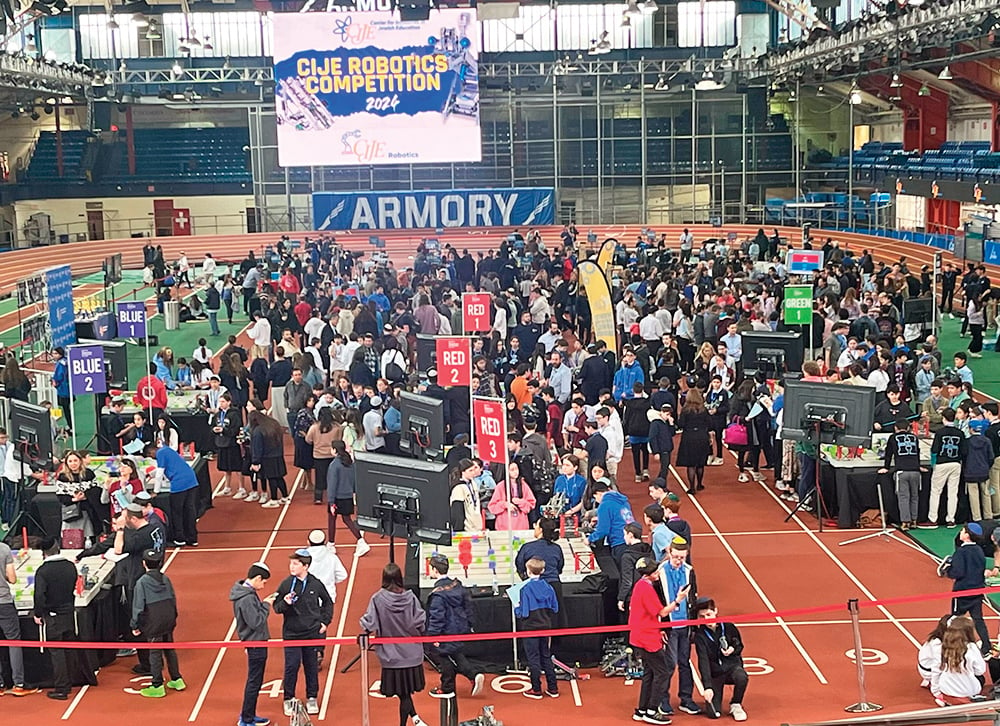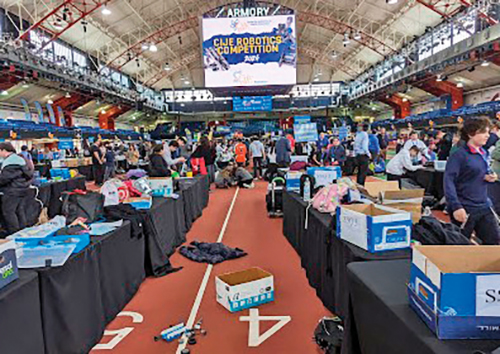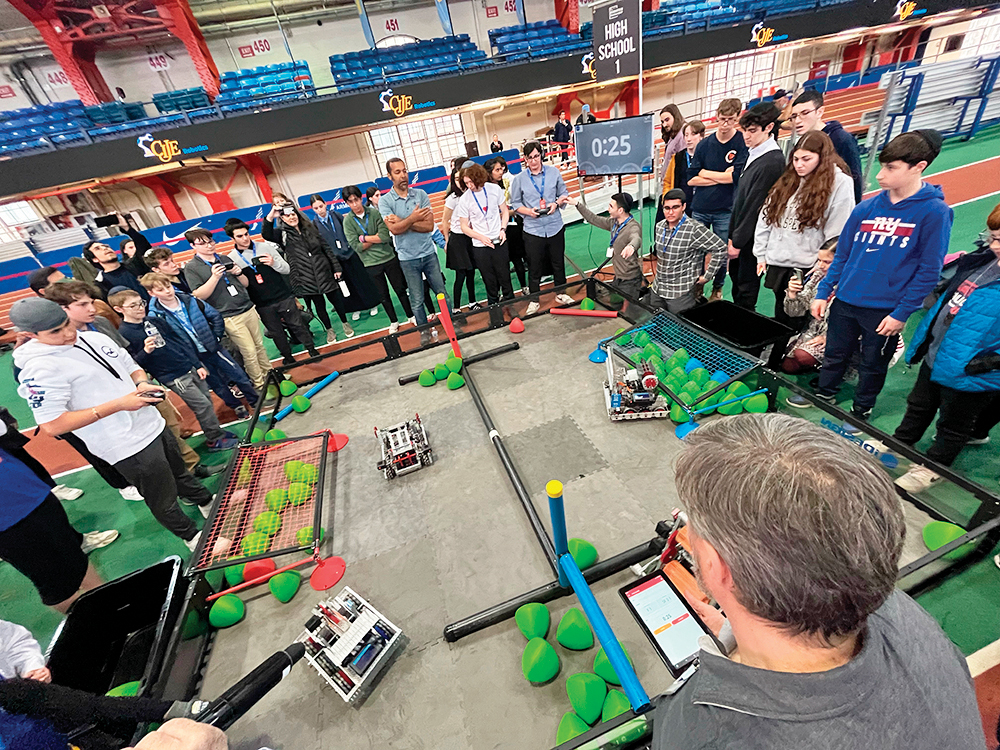Westchester Hebrew High School teams shine in first-ever CIJE outing.

Hundreds of students representing 56 teams from 23 high schools around the country competed at the CIJE Vex Robotics Tournament on Monday, April 1 at the Fort Washington Armory in Washington Heights. In the end, a pairing of a team from Westchester Hebrew High School (WHHS) and a team from Donna Klein Jewish Academy in Boca Raton, Florida defeated a combination of teams from Davis Renov Stahler Yeshiva High School for Boys (DRS) and Hebrew Academy of the Five Towns and Rockaway (HAFTR) for the championship.
Vex Robotics is an international company that designs robotics competitions for students all over the world. With a different game for high schoolers every year, Vex is the standard in robotics competitions, a rapidly growing area of STEAM activities in schools across the globe.
Due to most Vex tournaments being held over weekends (and therefore on Shabbat), competing is an issue in the Jewish community. That’s where the Center for Initiatives in Jewish Education (CIJE) steps in to make events like this one possible.
Created in 2001, CIJE coordinates educational programs in more than 175 Jewish schools across the country. Those programs impact the learning of more than 45,000 students each year and focus on both the ever-relevant (collaborating in teams, developing critical thinking skills and finding solutions) and the futuristic (the STEAM component). According to the organization, the goal is to prepare the next generation for innovation by funding programs with advanced technology; developing engaging curricula; and providing ongoing teacher training, mentorship and school visits by engineers.

In this case, CIJE invited high school teams from all types of Jewish schools throughout the country to compete for this year’s championship. Many schools in the tri-state area were represented, along with schools from communities including Baltimore, Silver Spring, Miami, Cleveland and Philadelphia. But CIJE does more than just host the tournament. They supply the schools with the materials to build the games as per the specifications that Vex sends out. This allows the schools to have a level playing field for the students to practice on and have access to during the year.
The CIJE Robotics League challenges students to work in teams throughout the school year to build robots and compete in multi-school tournaments, culminating in this event. Students learn advanced programming, mechanical building, teamwork and problem-solving through the process of building their robots and competing.
The high school division is the only one where the robots directly compete with each other. They do so in a two-on-two format that requires the teams to work together in order to defeat their opponents. The teams not only battle each other in the arena, but the design of the game makes teams decide what point scoring ventures are worth the risk.

The main part of this year’s competition featured tri-balls (best described as being similar to balls with curved edges and four triangular faces) as the teams attempted to get as many as possible across the floor to the other side of the playing field, and optimally into the opposing team’s scoring zone. To do this, teams had to first decide which robot would play which of the two needed roles. One robot was tasked with positioning itself in the loading zone and launching tri-balls across the playing field toward the other robot. Near the end of the round, this robot might also attempt to clear tri-balls out of its own scoring zone or side. The other robot positioned itself on the far side of the playing field and tried to push the tri-balls into the scoring zone.
Although this sounds complicated, the hard part is actually the bonus at the end of the round. Each team had a raised horizontal bar and one robot from each team could approach that bar and “climb” it for a bonus. In this case, “climbing” is the act by which a robot grabs the bar in some way and ends the round suspended from the bar without touching the ground. In the rare case that both robots climb their bars (this occurred mostly in the playoff rounds), the team with the robot highest off the ground was awarded a full bonus, while the lower hanging robot received a smaller one.
With so many variables, strategies abounded. There were robots that moved tri-balls by carrying them, throwing them, punching them, etc. There were robots that cleared balls away using a wedge, raking arms, a scoop and more. There were teams that focused on the climbing and there were teams that did not even bother to attempt it and instead used more time to focus on the projectiles.
Many schools actually had so much interest that they brought multiple teams. And while there was certainly a lot of fun going on, it was healthy competition as well. It might not literally be sports, but it would be hard to tell. Teams had everything from matching jerseys and sweatshirts to huddles and team chants.
The win was particularly momentous for WHHS given that it was not only their first year as a CIJE school, but also that they did not even have teams or robots from the start of the year. While most teams start in the fall and even attend a CIJE Robotics meet in November, Westchester STEM Director David Merel and his teams picked up the competition a little late.
Merel was a WHHS student himself (’98) and is in his second year teaching at the school. The students that he brought to the competition are in his advanced robotics course. In addition to the championship team, another Westchester team made the playoffs while the other two finished in the top 20.
While most robots in the tournament were run by teams of four or at least three, the Westchester teams were operated by only two members each. Not only that, but the team that took home the hardware for Westchester was the freshman duo of Reese Cohen (’27) and Abby Milchman (’27).

“I think that just being creative and training your mind in different areas of engineering is really great,” said Cohen about the experience.
So how did these upstart underdogs from a school that is both relatively small and new to the program place so well? According to Merel, there were two factors that put them over the top.
“Once we decided to enter, we actually spent our first few classes just trying to figure out the strategy,” said Merel about his teams’ preparation. “We watched videos of competitions and discussed options on what types of designs would yield the best results. We saw that a strong catapult would be best as long as the robot also featured a good hard nose in the front for pushing when needed.”
But the second key might have been what really allowed Westchester to win the championship.
“Teamwork was the biggest factor in this competition,” Merel said about his second point of focus. “You can’t win without the help of your partner and I feel like we all knew that coming in.”
Shir Yarmovski (‘26), one of the WHHS participants, agreed, “It means a lot to me that we won because it shows that our school is united as one team, and we can do anything with the right minds put together.”
With the way the tournament pairs students with different teams in qualifying matches, everything is kind of a whirlwind for a couple of hours as teams rotate through the schedule with different partners. But the Westchester teams kept their eyes on the scoreboards because it allowed them to find out who they were paired with next. They would then go find their partner teams and maximize the time before their match by comparing the strengths and weaknesses of their robots and devising a strategy for that specific round.
“We believe that this type of stuff is the future, so it’s a good thing to emphasize in school,” Merel said about robotics and other STEAM subjects. “The kids really put in the time and it was great to see them rewarded in the end.”
With STEM options increasing in schools everywhere, CIJE’s role to help facilitate corresponding growth in Jewish day schools is greater than ever. Their goal is to be there for whatever is next for the future in STEM education and events like these demonstrate how happy the students are that CIJE is there to help them expand their educational horizons.
| 1st | Westchester Hebrew High School (NY) |
| Donna Klein Jewish Academy (FL) | |
| 2nd | DRS (NY) |
| HAFTR (NY) | |
| 3rd | HAFTR (NY) |
| Ramaz (NY) |










